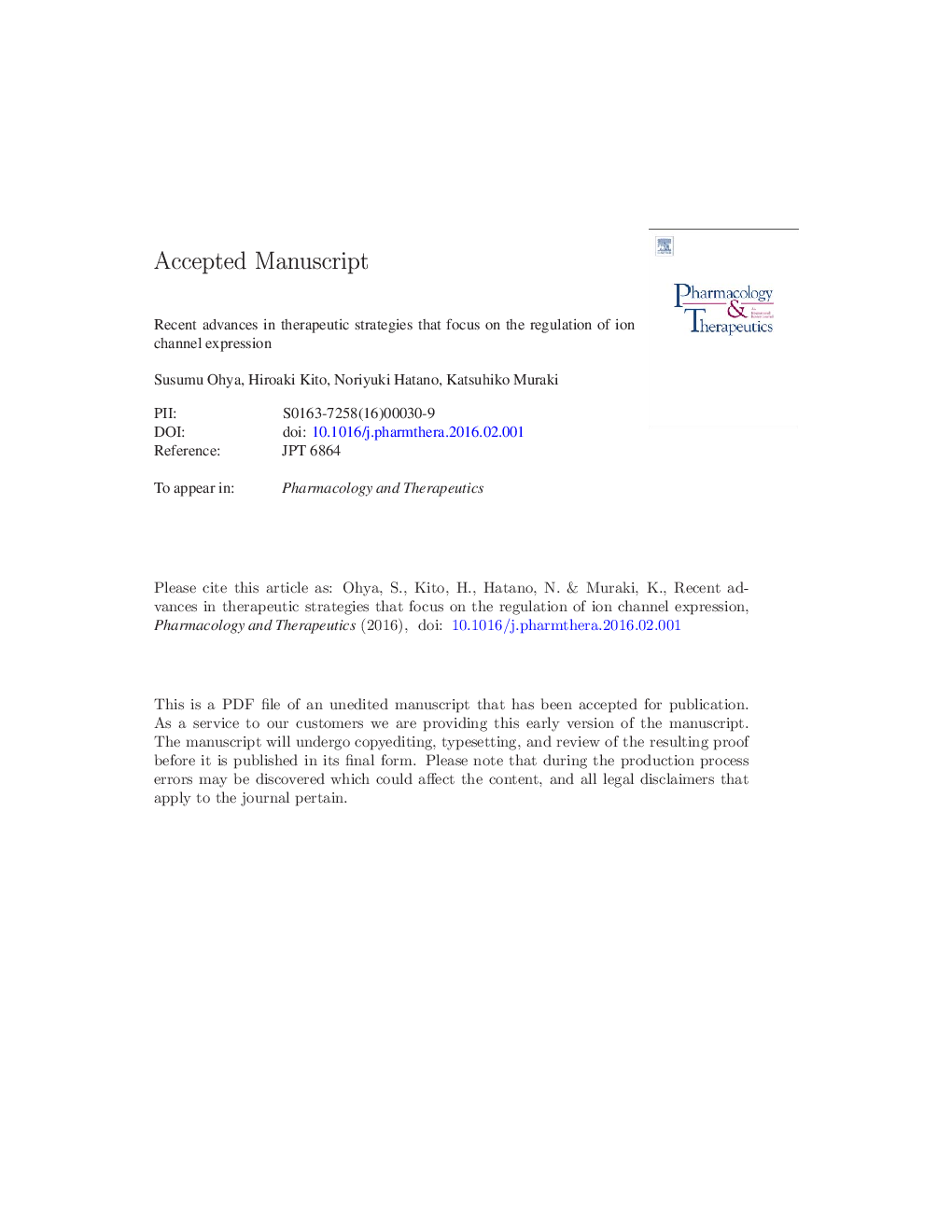| کد مقاله | کد نشریه | سال انتشار | مقاله انگلیسی | نسخه تمام متن |
|---|---|---|---|---|
| 5843892 | 1560945 | 2016 | 171 صفحه PDF | دانلود رایگان |
عنوان انگلیسی مقاله ISI
Recent advances in therapeutic strategies that focus on the regulation of ion channel expression
ترجمه فارسی عنوان
پیشرفت های اخیر در استراتژی های درمانی که بر تنظیم بیان کانال یون تمرکز می کنند
دانلود مقاله + سفارش ترجمه
دانلود مقاله ISI انگلیسی
رایگان برای ایرانیان
کلمات کلیدی
AMPKNF-κBPI3KEGFlncRNADRGNFATPAHTrpATISUMOPAMHDACHUVECSRFpKaCaMKNGFIP3NMDAP-1HDACiAITCTRPAPKCTRPVKirTGFHSF1ANGIIHIFHRENRSFARFTRPMPHDMITFVDREADPRKCaESCRTRunx1AKAPTRPCLNCaPK2Pandrogen responsive elementCa2+-activated Cl− channelLQTWNKNHERF-1TNFTwo-pore domain K+ channelADP ribosedorsal root ganglion - گانگلیون ریشه پشتی5′ AMP-activated protein kinase - 5 'پروتئین کیناز فعال AMPinositol 1,4,5-trisphosphate - inositol 1،4،5-trisphosphateK+ channel - K + کانالMAPK - MAPKLong QT - QT طولانیlong non-coding RNA - RNA بدون رمزگذاری طولانیSGK - SSIHydrogen peroxide - آب اکسیژنهalternative translation initiation - آغاز ترجمه جایگزینSTAT - آمارAngiotensin II - آنژیوتانسین دوAllyl isothiocyanate - ایزوتیوسیانات آللییلchromatin immunoprecipitation - ایمن سازی کروماتینAlzheimer's disease - بیماری آلزایمرtransforming growth factor - تبدیل فاکتور رشدProtein degradation - تخریب پروتئینElectrophoretic Mobility Shift - تغییر حرکت الکترو فوریتیCNS - دستگاه عصبی مرکزیTranscription - رونویسیCAM - ساخت به کمک کامپیوترHuman umbilical vein endothelial cell - سلول اندوتلیالی ورید ناقل انسانیEMSA یا electrophoretic mobility shift assay - سنجش تغییر تحرک الکتروفورتیکUbiquitin-proteasome system - سیستم Ubiquitin-proteasomecentral nervous system - سیستم عصبی مرکزیendoplasmic reticulum - شبکه آندوپلاسمی SNAP - ضربه محکم و ناگهانیneuron-restrictive silencer factor - عامل خنثی کننده محدود کننده نورونEpithelial growth factor - عامل رشد اپیتلیالrunt-related transcription factor 1 - عامل رونویسی مرتبط با ریت 1heat shock factor 1 - عامل شوک گرما 1nuclear factor of activated T-cells - عامل هسته سلول های فعال شده فعال استHypoxia responsive element - عنصر پاسخگو هیپوکسیADP-ribosylation factor - فاکتور ADP-ribosylationHypoxia-inducible factor - فاکتور القاء کننده هیپوکسیnerve growth factor - فاکتور رشد عصبMicrophthalmia-associated transcription factor - فاکتور رونویسی مرتبط با میکرو فتالمیtumor necrosis factor - فاکتور نکروز تومورnuclear factor-κB - فاکتور هسته ای κBserum response factor - فاکتور پاسخ سرمیnonsense-mediated mRNA decay - فرسودن mRNA ناشی از بی معنی استphosphoinositide 3-kinase - فسفینوزیتید 3-کینازPulmonary arterial hypertension - فشار خون شریانی ریویSignal transducer and activator of transcription - مبدل سیگنال و فعال کننده رونویسیendosomal sorting complex required for transport - مجتمع مرتب سازی آندوسومی مورد نیاز برای حمل و نقلhistone deacetylase inhibitor - مهار کننده هیستون داسیدلازCAN - می توانMicroRNA - میکرو RNA MiRNA - میکروRNA، ریزآرانای، miRNAARE - هستندH2O2 - هیدروژن پراکسیدhistone deacetylase - هیستون داستیلازtransient receptor potential - پتانسیل گیرنده گذراA-kinase anchoring protein - پروتئین anchoring A-kinaseactivator protein-1 - پروتئین فعال کننده-1synaptosomal-associated protein - پروتئین مرتبط با سیناپتوزومالprotein kinase A - پروتئین کیناز AProtein kinase C - پروتئین کیناز سیmitogen-activated protein kinase - پروتئین کیناز فعال با mitogenCa2+/calmodulin-dependent protein kinase - پروتئین کیناز وابسته به کلسیم و پتاسیم Ca2 + /Prolyl hydroxylase - پرولیل هیدروکسیلازpre-mRNA splicing - پلاسمایی قبل از mRNASingle-nucleotide polymorphism - پلی مورفیسم تک نوکلئوتیدیSNP - چندریختی تک-نوکلئوتیدCHiP - چیپcaveolin-1 - کائولین-1Calmodulin - کالمودولینCa2+ channel - کانال Ca2 +Voltage-gated K+ channel - کانال K + با ولتاژCa2+-activated K+ channel - کانال K + فعال شده Ca2 +Cav-1 - کاو-1Calcineurin - کلسینورینsmall ubiquitin-like modifier - کوچک مانند ubiquitin مانند اصلاح کنندهAndrogen Receptor - گیرنده آندروژنیUPS - یو پی اس
موضوعات مرتبط
علوم پزشکی و سلامت
داروسازی، سم شناسی و علوم دارویی
داروشناسی
چکیده انگلیسی
A number of different ion channel types are involved in cell signaling networks, and homeostatic regulatory mechanisms contribute to the control of ion channel expression. Profiling of global gene expression using microarray technology has recently provided novel insights into the molecular mechanisms underlying the homeostatic and pathological control of ion channel expression. It has demonstrated that the dysregulation of ion channel expression is associated with the pathogenesis of neural, cardiovascular, and immune diseases as well as cancers. In addition to the transcriptional, translational, and post-translational regulation of ion channels, potentially important evidence on the mechanisms controlling ion channel expression has recently been accumulated. The regulation of alternative pre-mRNA splicing is therefore a novel therapeutic strategy for the treatment of dominant-negative splicing disorders. Epigenetic modification plays a key role in various pathological conditions through the regulation of pluripotency genes. Inhibitors of pre-mRNA splicing and histone deacetyalase/methyltransferase have potential as potent therapeutic drugs for cancers and autoimmune and inflammatory diseases. Moreover, membrane-anchoring proteins, lysosomal and proteasomal degradation-related molecules, auxiliary subunits, and pharmacological agents alter the protein folding, membrane trafficking, and post-translational modifications of ion channels, and are linked to expression-defect channelopathies. In this review, we focused on recent insights into the transcriptional, spliceosomal, epigenetic, and proteasomal regulation of ion channel expression: Ca2+ channels (TRPC/TRPV/TRPM/TRPA/Orai), K+ channels (voltage-gated, KV/Ca2+-activated, KCa/two-pore domain, K2P/inward-rectifier, Kir), and Ca2+-activated Clâ channels (TMEM16A/TMEM16B). Furthermore, this review highlights expression of these ion channels in expression-defect channelopathies.
ناشر
Database: Elsevier - ScienceDirect (ساینس دایرکت)
Journal: Pharmacology & Therapeutics - Volume 160, April 2016, Pages 11-43
Journal: Pharmacology & Therapeutics - Volume 160, April 2016, Pages 11-43
نویسندگان
Susumu Ohya, Hiroaki Kito, Noriyuki Hatano, Katsuhiko Muraki,
